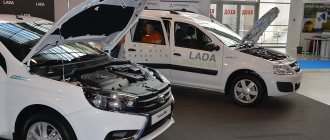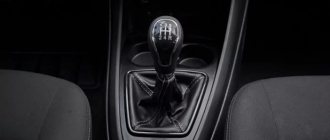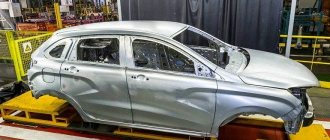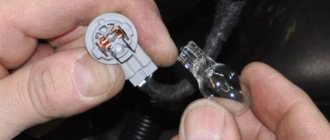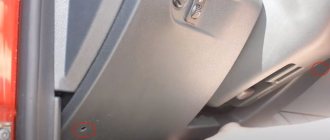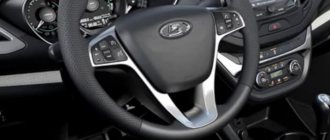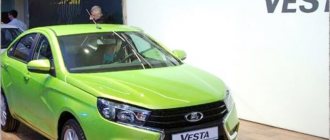Comparison of Lada Vesta and Lada Priora
Auto engines
Models interior
Our automobile industry produces a fairly wide range of cars. Starting from outdated to the most modern models. For comparison, we will select cars with production beginning in 2007 and 2015. and we will try to answer which is better: Lada Vesta or Lada Priora.
Assessing the appearance of the cars, we come to the conclusion:
- Priora has an attractive, but outdated body type;
- Vesta is an example of a modern European car. It looks like a prestigious and expensive car that will be in demand on the market for a long time.
These two cars are classmates, both are budget options. It’s not a shame to put Vesta on the same line as the best one-class foreign cars.
It was this car that became a breakthrough for AvtoVAZ. Priora was produced in sedan, station wagon and hatchback bodies. There are currently only two body styles in production, a sedan and a station wagon. Vesta is just entering the market and is also available in sedan and station wagon versions.
A brief overview of the appearance of Vesta and Priora
Vesta personifies the European modern typical car. The look is quite expensive and prestigious, and the model is in demand on the market. In turn, Priora, although attractive on the outside, is still a rather outdated body type.
Each of the models under consideration is a budget option and is classmates. Many will say without hesitation that Vesta can be placed next to the best foreign cars of the same class. For the automaker AvtoVAZ, this model became a real breakthrough. As for the Priora, it was initially produced in 3 body types: hatchback, station wagon and sedan, at the moment there are only 2 bodies in operation - station wagon and sedan. Vesta is released in exactly these bodies. In terms of exterior, it’s easy to determine which is better when Vesta or Priora is in the balance. Most likely, everyone themselves realized that the fresh solution - Vesta wins this dispute.
14.43. Corrosion of metal
Approximately 70% of the cost of a car is determined by the condition of the body. And it, in turn, depends on whether the car has been in an accident and, most importantly, on the degree of its corrosion damage.
The causes of accelerated corrosion are divided into two groups and are related:
– with design or technological features of specific models; – with external influences.
The first group includes:
– the occurrence of high voltages and vibrations of the body metal; – the presence of “pockets” in the load-bearing sections of the bodies; – use of thin metal sheet (0.7–0.8 mm); – the use of metal with impurities that increase the corrosion rate; – the presence of corrosion concentrates in the form of moldings and other decorations.
External influences include:
– sulfur compounds, carbon dioxide and chlorides contained in the environment; – saline solutions used to combat ice.
In our conditions, various salt solutions have the greatest impact, since they lead to the formation of conductive “bridges” between body parts, which, as a rule, have different electrical potentials. This causes the most rapid type of metal destruction - electrochemical corrosion. The bottom line is that all cars have a single-wire electrical circuit, and, therefore, currents “walk” through the body from one consumer to another.
We will not delve further into the theory, leaving it to specialists in the field of corrosion, and turn to practical issues. These results are based on the use of three types of instruments during the examination, which make it possible to evaluate:
– change in the thickness of the “living” metal, that is, not subject to corrosion; – the degree of erosion of the metal from the inside, in other words, the degree of its loosening or destruction by oxides; – the thickness of cosmetic layers (paint, putty), which allows you to determine whether the body has been repaired and attempts to hide it.
The results of the examinations carried out by specialists allow us to draw the following conclusions:
1. In the conditions of our region, the rate of corrosion penetration into metal for cars with winter operation is 0.2 mm per year and 0.1 mm per year for cars that have not seen salt.
2. Corrosion develops especially quickly in areas that have undergone body repairs, and very quickly if this repair was carried out using welding or soldering, since electrochemical pairs are created from dissimilar metals. For those buying a car, especially a foreign car, this is fundamentally important. It’s not for nothing that thrifty Europeans almost always sell even a slightly damaged car (albeit after receiving insurance) for next to nothing – $1–2 thousand. The reader probably knows for himself how much they are then resold in our markets. But if you are lucky enough to discover a hidden defect before making a purchase, know that the real cost of such a car is 25–50% lower than that of an undamaged one. We must not forget that sooner or later you will be selling a car, and without experts, only very naive people now make expensive purchases.
Body parameters of Lada models
The manufacturer of the cars we are considering is going to expand their line of bodies. It is known that Priora was the base for the development of Vesta. Even so, the cars have nothing in common from a visual point of view. The model has a unique design and a body increased in width and length. If we compare the design of West or Prior, we can definitely say that the new product is much better than its predecessor.
We continue the comparison to find out which is better. As we noted earlier, Vesta is made in a completely European style. Priora is more archaic, and here competitiveness is zero. When developing Vesta, the company’s specialists were faced with the task of creating the most beautiful and elegant design in order to stand out from Russian cars.
Exterior
The appearance of the cars cannot be compared. Vesta is a stylish and modern model, with slanted headlights, an aggressive radiator grille, a sloping hood, a powerful air intake and the inevitable chrome lines designed to form the letter “X”, making the full face more recognizable.
Vesta’s powerful front end is definitely impressive.
From the side it looks no less impressive. Of course, the x-shaped stampings that run along all the side panels will bring a lot of trouble to tinsmiths in the event of restoration after an accident (most likely, the part will have to be replaced with a new one), but if you didn’t want to think about the bad, then this image, complemented by beautiful wheels, definitely impressive.
The car looks no worse from the side.
There is no dissonance at the back either. The sharp angles and straight lines of the lights harmonize perfectly with the simple and clear outlines of the trunk lid and rear bumper. And the decoration of the car is large, chrome-plated LADA letters.
The design of the Lada Vesta was also a success for the designers.
Priora doesn't look so fresh. And in general, its appearance resembles an outright plagiarism of Japanese and Korean models of the early 2000s (such as Lancer 9, etc.). A “rare-toothed” radiator grille, convex headlights, a stepped bumper shape, beaded fog lights and other elements that seem archaic compared to modern cars.
The appearance of the Lada Priora, of course, is not so bright.
From the side the car looks good. A straight line running across the entire sidewall, a curve along the bottom of the doors, nice wheels - nothing special, but nothing superfluous either. The same applies to the stern - the feet, trunk and bumper are simple and unpretentious. The only thing that dilutes the picture is the chrome on the trunk lid.
And from behind, her features frankly lack modernity.
Comparison of internal equipment of Lada Vesta and Priora
Comparing models in order to identify which is better in terms of internal “decoration” is also very specific, since Priora, whatever one may say, is more outdated. The new product from Lada has a multifunctional steering wheel, which allows you to use various functions of the on-board standard computer and, accordingly, the radio.
The dashboard design was developed by specialists hired by AvtoVAZ from France. Thanks to this, the “tidy” received a modern design, a large color display, and a computer shows the time, fuel consumption and other necessary parameters. Thanks to the computer, you can analyze the operation and diagnose the machine. Below there are buttons that the driver uses to control the stereo system and air conditioning, if it is included in the package.
Vesta or Priora equally have a comfortable seating position, but Vesta has a more spacious interior. Also, the visibility in the car does not cause any complaints.
Interior
After the restyling, the interior of the Lada Priora became much more expressive and modern. A new dashboard, a large display in the middle of the dashboard, an updated center console - all this has ennobled the interior of the sedan. But the same features of the panel, the same gear lever, steering wheel, seat upholstery, flaws in the assembly and other points remind of the previous interior of the car.
The interior of the LADA Priora is generally not bad, but not impressive.
Vesta's salon is fundamentally different. A completely different design, created in the style of modern foreign cars, a large display that fits harmoniously into the interior, and does not break out of it, as in the Priora, an impressive dashboard, high-quality operation of the climate system, well-profiled seats with good lateral support, space, etc.
Vesta's salon looks much more interesting.
In general, the interior of the LADA Priora is acceptable, but after Vesta it leaves a clear feeling of unfinished and lack of harmony.
We compare the technical parameters of two Lada models
Let's continue the comparison. The turn reached the technical parameters. Vesta or Priora are equipped with exactly the same power plants. Vesta has one exception, since in one of the trim levels you can install a Nissan engine for an additional fee. The maximum speed of the car is 185 km/h. The model accelerates from zero to 100 km in 10.3 seconds, but the Priora is 0.7 seconds longer. Rumor has it that a new 1.8L engine will soon be developed, which promises to be more powerful.
Vesta has one important innovation. The fact is, the car can run on both gasoline and gas. Moreover, the HBO is factory-installed. The model is equipped with a 5-speed gearbox, modernized from Priora, and also has a robotic MT, made in France. Priora is equipped with an old manual 5-speed gearbox.
Valve adjustment Kalina 8 valves
Ignition coil Kalina
How to check the DMRV on Kalina
Transmission
Compared to the Priora, the manual transmission of the newest car has several advantages. Firstly, the new model has an imported gearbox, which was borrowed from Renault. This allowed the engineers to completely eliminate all kinds of noise that came from the box in the previous version. The developers thought for a long time about how to fix this problem on their own, but never came to a solution. Secondly, the clarity of gear shifts on the latest model is much better. Now the gears are switched on very smoothly and briefly. On the Priora, the gearbox turns on quite slowly and constantly trembles. As a result of installing a new box and some improvements, this segment has become significantly better.
Chassis design features
In all class B models of cars produced by AvtoVAZ, the same components are present in the chassis design. In this case, only the settings differ, and radically.
Even despite this design similarity, Vesta has more ground clearance than Priora, and it handles better on the road; there is practically no wave swing on uneven roads, and there is no roll when cornering.
Vesta passes minor bumps on the road with ease, and passengers in the cabin almost do not notice it. If the potholes on the roads are more significant, then an incomprehensible knocking sound begins to be heard, and passengers and the driver experience discomfort while driving. As experienced Vesta owners say, this defect can be eliminated; for this purpose, you will have to install special washers under the rear pillars.
Video review of Lada Vesta
At the bottom of the console there is space for an air conditioner.
The Korean also has a wonderful instrument panel, in some ways it is similar to other representatives of cars in this class. The steering wheel can be adjusted to its height. But the driver's seat is quite comfortable, has extensive adjustments, but, according to reviews from owners, it does not have enough lumbar support. They also noted the inconvenient location of the armrests and gear shift knob. The console fits seamlessly into the interior; some versions will be equipped with air conditioning.
Vesta designers selected beautiful, elegant and practical materials for interior decoration. It is impossible to find soft plastics in it, but the convenience did not suffer from this. The rear sofa is not very prominent, but three passengers can fit comfortably on it, although if you are tall, the ceiling height will be a little lacking. The trunk measures approximately 480 liters. The spare wheel is hidden in a special niche, and the back of the rear seat can be folded to transport large cargo.
Compare interior sound insulation of Priora and Vesta
Which is better when comparing the sound insulation of Vesta or Priora? Vesta has an advantage in this regard; in particular, the difference can be clearly felt when driving along the highway at high speed.
Extraneous noise can be heard in the Lada Priora even if the driver has additionally performed sound insulation. Owners of the model complain that the noise from the engine does not disappear with additional insulation. In Vesta, the roar of the engine will be heard exclusively at high speeds. As for the sound from passing cars, with the windows closed, the noise will be heard at a minimum distance.
As for the brakes, both models are at the proper level and do not cause any complaints from the owners.
Which car is better to use: Priora or Solaris
It is not entirely correct to compare a representative of the domestic automobile industry with the Korean one. Although often future owners choose between Priora and Solaris. This is due to the fact that you can buy a fully equipped Lada for almost the same money as a “Korean” in the “comfort” assembly. In terms of their technical characteristics, these cars are similar, but in terms of operation they will have differences. A comparative analysis will help solve the question of which is better - Lada Priora or Hyundai Solaris.
Let's sum it up
Summing up, it becomes obvious which model is better than Vesta or Priora. AvtoVAZ began to produce excellent cars, and the new Vesta is clear proof of this. Having studied all the parameters of the cars, a potential buyer in the showroom is unlikely to have a question about which model to give his preference to Vesta or Priora.
Modern pipes for water or gas are made of plastic, such pipes are considered more durable than simple metal, you can purchase such pipes in many places, in chain stores, or order a batch via the Internet https://ingplast.ru/polietilenovye-truby/, often when ordering The price online will be lower than in hardware stores.
Lada Vesta vs Nissan Almera (Vesta vs Almera)
At -15 degrees the Priora did not always start, and at -21 it never started. Despite the Korean production, Solaris turned out to be more ready for Russian winters, even at -27 there were no problems with starting. One more point: the front part of the Priora has to be covered with polyethylene or a cardboard sheet, as the engine temperature drops. Solaris warms up perfectly, and there is no need to come up with additional protection.
- Controllability. This is where the domestic auto industry showed itself better - at any speed, the Priora goes great on the highway, but the Solaris starts to wobble at 120 km/h. In strong winds, the “Korean” is literally blown off the road, you have to steer, which is very tiring during long journeys.
- Load capacity. Here again the domestic manufacturer has a victory; the Priora calmly transports the 450 kg stated in the document and travels with a load just as well as it does lightly. Solaris claims to be able to transport 380 kg, but the stern settles already at 200. The ground clearance becomes such that you need to carefully monitor the road; on a bump, the edge of the disc can be damaged.
- The sound insulation of both cars is approximately the same, although the interior of the domestic representative has to be modified with self-tapping screws so that the shelf holders do not rattle.
- Maintenance. At the official Priora dealer, the prices for work are greatly inflated, but you don’t have to visit maintenance, no specific work is carried out. The cost of spare parts when repairing a domestic car is such that there is no point in looking for used options or purchasing non-original options. As for Solaris, visiting a dealer for maintenance is a condition of the warranty; you have to get it serviced. The prices are not too high: every 15 thousand kilometers you need to pay about 1500-2000 rubles and compensate for the cost of consumables. There was no need to spend money on spare parts during the first 100 thousand kilometers.
- rear shock absorber: 1350 and 2770 rubles.
- front pillar 2600 and 4100 rub.
- driver's door 10500 and 19300 r
- rear drum 800 and 7800 rub.
If you need a car with excellent load capacity and handling, then you should choose Priora. On it you will have to constantly monitor the engine, but in winter you should not count on starting the car. Solaris is an excellent car for city use, reliable and comfortable. If you don’t like fast driving on the highway or don’t often carry loads, then you should pay attention to this one.
Related articles:
Loading. Please wait. The fate of AvtoVAZ will be decided in France. The AvtoVAZ modernization program is ready and will be implemented if the Prime Minister...
Lada Vesta received an expensive Exclusive version Tuning Lada Vesta photo review Description: Luxe/Prestige package Offer updated on October 05…
What are the differences between the new Renault Duster 2015? from the old one? Some time ago we wrote about...
Mitsubishi. On Wikipedia they write “Mitsubishi”! In Russia for some reason they say Mitsubishi, Fukushima, but everywhere else they say Sh.. a...
The most popular car at one time on the domestic market was the Lada Priora, and if you look at the roads of the regions (not taking into account Moscow and St. Petersburg), then you can see them most often from our automobile industry. Despite its disadvantages, which of course are present in large numbers, there are also many advantages.
We will talk about the merits of this car below, and I will try to give at least 5 good reasons not to give up the Priora in order to exchange it for Vesta.
1. The car is much cheaper initially , and if it were produced now, the difference in price would be about 150,000 rubles. Of course, for some, 150 thousand is not money, but for buyers of domestic cars it is a very significant amount, when some people have salaries in the country of 15-20 thousand rubles a month.
2. Maintenance costs are much lower. If you have been driving a Priora for a long time, then most likely you already know by heart the price lists for spare parts for your “cart”. Yes, everything is expensive now, but when compared with Vesta parts, Priora parts are sometimes several times cheaper.
Here are a few items by which you can compare the cost of spare parts for Priora and Vesta, respectively:
According to the last comparison, to be precise, you can add to 800 the cost of a hub with a bearing, but even in this case the price will not exceed even 2000 rubles. and the difference between 7800 is simply huge. You could list prices for parts here for a long time, but for almost every item it will be the same as what you saw above.
3. Priora's fuel consumption is lower. The engines of these cars are the same in most cases, but Vesta’s gluttony will definitely be more noticeable, since the car is heavier, the gearboxes are different and you will definitely save 1 liter per hundred if you drive a Priora.
4. Better dynamics. If you have driven both one and another car, then most likely you understand perfectly well what we are talking about. If Vesta accelerates to 100 km/h in 11.8 s, then Priora in 11.5 s. But this is passport data, but in practice it’s only 1-1.5 seconds if you compare cars with the same engines.
You can, of course, compare 1.8 on a manual Vesta and Priora on a robot with 1.6, but this will not be a completely fair comparison.
Russian brand TSN
Russia has its own domestic concern - a giant that produces a wide range of components and consumables for cars. This is the Zircon concern, whose office is located in Moscow, and its main production facilities are in the Stavropol Territory, in the city of Mikhailovsk.
The range of products is very wide, covering all the product needs of car owners. Having opened a workshop for the production of brake pads back in 1999, today the concern produces front, rear, drum and disc brake pads for more than 80% of all foreign cars and all models of Russian cars. In addition to simple ones, the range includes pads with wear sensors.
